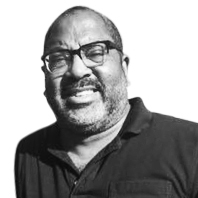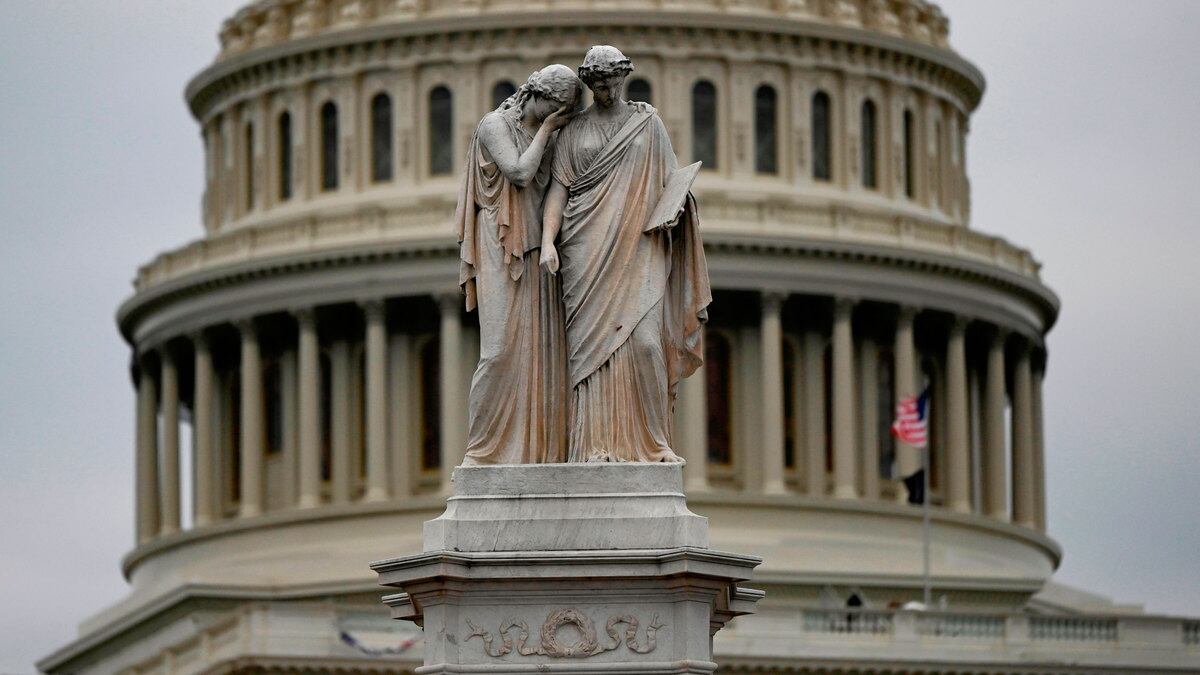The timing for the thugs that stormed the capitol could not have been worse for them. On the day that the progressive nation was revelling in the historic election of Georgia’s first ever Black senator as the Democratic party reclaimed control of the U.S. Senate, rioters waved Confederate flags as others shouted “white power” at a Black photographer documenting the mayhem. The treasonous rioters stole the spotlight from the celebration of American progress with a horror show—Nightmare on Capitol Hill. America saw a portrait of Trumpism that forced some of the president’s devout loyalists like Lindsay Graham and Kelly Loeffler to run for cover and retreat from their insane objections to the Electoral College vote.
By Thursday, Wayne Ridge, a Republican county commissioner in Michigan’s Eaton County, started watching a show on pirates. “I have stopped watching the news,” he said. “From my point of view, you know, we lost the election and then we lost the senate as well. It’s depressing. I have gotten some information by phone about some Antifa people at the capitol building."
“Do you really believe that?” I asked him.
ADVERTISEMENT
“I don’t know,” he answered. “I mean, part of me is like ‘I don’t want to believe that Republicans would do something like this.’ I don't know but I do know that Antifa did a lot of damage in Portland and Seattle and other places. I don’t have all of the information and it is tragic and sad and that angers me. It’s like two different worlds out there and I am very disappointed.”
Ridge had many reasons to swell with red pride on November 3. Not only was he easily reelected to another term as a county commissioner, but the GOP won the majority of the 15 seats on the commission for the first time in several years. In addition, all the talk about how Scranton’s own Joe Biden would have strong appeal among the county’s large rural white working class population didn’t add up to much in the county that Obama actually carried in 2008 and 2012. Trump, the native New Yorker who’d turned Eaton red in 2016, carried it again in 2020.
But for Ridge, the good election news ended in Eaton. He says he still can’t help but smell something foul about the Biden victory and that he’d hoped his questions would be answered when Congress met on Wednesday. “There are so many different things here that seem out of place,” he says. “Nationwide how is it that Biden won more votes than Obama won in both of his elections, and Obama was popular. I saw the masses at all the Trump rallies and the excitement for him. He was drawing in tens of thousands of people. Then I was watching Joe Biden and Kamala Harris and they weren't really doing a whole lot of them. They had rallies with only dozens of people and Biden didn’t come out of his basement much.”

Ridge is far from the only local conservative elected official in a swing Obama-Trump county still entertaining the idea of gross irregularities in 2020 that add up to the possibility of a stolen election. Mountains of highly credible findings that prove otherwise can not compete with the commentary Ridge and many others hear from Rush Limbaugh and Fox News. They did not have a true opportunity to see Republicans legitimately wage the election argument that most Americans see as pure lunacy. Rioters destroyed that dream and Trump loyalists had to settle for listening to speaker after speaker denounce their leader and the insurrectionists who followed his commands.
“I'm appalled by everybody, by Trump's actions, by the rioters or whatever you want to call them,” says Richard Regula, a Republican who was reelected county commissioner in Ohio’s Stark County, also an Obama-Trump county. “It's a sad, sad day for America. Watching that on TV brought back a lot of memories of all the years Dad spent in Congress.”
His father, the late Ralph Regula, was a Republican congressman who served from 1979 to 2008, representing a district nearly evenly split between Democrats and Republicans covering Stark County. Richard, 63, who voted for Trump in 2016 and 2020, is the youngest of three children—each of them with somewhat different views and voting habits. His older sister, Martha, 68, is a Democrat and his brother, David, 67 is a Republican who voted for Clinton in 2016 and Biden in 2020.
“When my father was there it was so, so much more bipartisan,” says Martha Regula. “People worked across the aisle. Nancy Pelosi was one of his best friends. He worked with her on numerous bills… Now we’re so divisive. It’s hard, people are working the party line instead of working together. Can we get back to that point again? I don’t know. I would hope so but it depends on the leaders in both parties. I think the GOP should take back its party. It shouldn’t be the party of Trump.”
Her other brother, David Regula, 67, a former Republican trustee in the town of Bethlehem, wants to “live long enough to bring the Republican Party back to what it is where it's fiscally responsible, cares about all segments of our population — Black, white, Hispanic, culturally across the board — and we get back to what we were as a party. I hope this Trump segment is just a blip on the radar screen and goes away. I do have Republicans who think in four years Trump is going to be part of the equation. If his final hurrah was Wednesday, and I think it's what the people are going to remember, he'll be nobody in four years. But I still don't know, in my lifetime, if this party has had the ability to rebuild itself from this travesty we've just experienced. That's a difficult thing to say, as a Republican. I think it's torn the Republican party apart.”

The Regulas, clockwise from left: Ralph, Richard, David and Martha
Courtesy of Martha RegulaFour years ago, David struggled with the question of who to vote for until his then 11-year-old daughter, Marissa, asked him, “Dad, would you vote for a man that has done all those things to women?”
“Now, I'm very proud that I didn't vote for Trump,” says David Regula. “Because I would be ashamed by the actions of what he has done and how he has segregated this country. It's just astonishing. It's terribly sad that we have a situation like we did yesterday.”
Meanwhile the Washington riot compelled his brother, Richard, again a Trump voter, to now say he’s “putting his faith in Biden to heal the country.” Both brothers say they do not spend a lot of time talking politics with one another, even though they live within a half mile of each other. In a divided swing county like Stark, people avoid the conversation. “What's happened, from a Republican standpoint, in the last four years,” explains David, “If you did not vote for Trump, you've learned to not bring up that conversation. They’re some loyal Republicans that are Trumpsters, as we call them, and we don't discuss it anymore with them because we don't want that aggravation.”
After Wednesday, it is more difficult to avoid the conversation in, of all places, a swing county where differing opinions are not as rare as they are in solidly blue and red places. However many purple counties like Eaton and Stark began to bleed red four years ago. America’s urban-rural divide has grown far beyond what it was in 2008 when Obama won counties like Stark and Eaton. This widening gulf was reinforced by the rejection of Biden, who won back only 25 of America’s 206 Obama-Trump counties.
“The lay of the land politically has changed over the last decade or so in a way that Trump leverages and exploits and Biden was not able to sort of recapture the magic of the Obama moment because the Democratic Party of today is not the same as the one in ‘08,” says Theordore Johnson, a senior fellow at the Brennan Center who focuses on the role of race in electoral politics. “Whereas maybe a rural predominantly white county would be open to a pitch from a Democrat, even a Black Democrat in 2008, that pitch today is seen as grounded in socialism.”
David Redlawsk, Chairman of the Department of Political Science and International Relations at the University of Delaware, says the poor showings of Biden in swing rural counties could be a sign of more of an emerging brand political isolation that leads some people to the kinds of fringes that were on display Wednesday in Washington. “And then social media makes it much easier for people to live in certain boxes,” he adds. “Ultimately it is about getting out of the bubble and having the opportunity for experiences to challenge your beliefs in a healthy way.”
He uses his own transformation as an example. He was an ardent young Republican who came of age in rural Pennsylvania in the Seventies. So how did he end up as an Obama delegate at the 2008 Democratic convention? “I was in the MBA program at Vanderbilt, but fell into a position at Fisk University as a teacher and an administrator. Of course Fisk is a historically Black university. I was one of the only white administrators, I did it for four years and that for years made a huge difference in me. The people I met, the people I talked, to the students I taught were all coming from backgrounds that were so different from mine. So, you know that is pretty hard to replicate what can be expansive for any one individual but the bigger picture isn't which is you'll have to break out of just doing the same thing and talking to the same people and listening to the same media all the time.That to me is the the key.”
Classifications of swing counties are also being redefined under the influence of the sharp urban-rural divide. In 2008, Obama won 272 counties that George W. Bush had won in 2000 and 2004. Only 116 of those counties remained in the blue column in 2012. While some Bush-Obama counties in the Upper Midwest and Northwest were rural, many others contained an urban center, such as Harris County which includes Houston; Hillsborough County which includes Tampa; Wake County which includes Raleigh; Hamilton County which includes Cincinnati. There are also counties like Dallas and San Diego which, of course, includes cities of the same names. Hillary Clinton won all six of those Bush-Obama counties in 2016. When it comes to Obama-Trump counties, Florida’s Pinellas County, which includes St Petersburg, is one of the most populated and one of the 25 that Biden returned to the blue column.
Biden’s support among African Americans and young voters in suburban areas of Philadelphia, Milwaukee, Detroit and Atlanta mitigated Biden’s poor performance in swing counties. “We have anywhere between 52-55% as the estimate for youth turnout for 2020,” says Kei Kawashima-Ginsberg, Director of the Center for Information and Research on Civic Learning and Engagement at Tufts University. “This compares pretty favorably for the estimate range 42-44% for 2016.”
In Georgia, not only did Biden lose all five of the state’s Obama-Trump counties, but so did Democrats Ralph Warnock and Jon Ossoff in their successful US senate races against incumbent Republicans Kelly Loeffler and David Perdue. In all three races, increased turnout by young voters and African Americans more than compensated for Democratic losses in the Obama-Trump counties. “The national narrative about Joe Biden's victory is about him being able to make some inroads with white suburban voters, just enough with white suburban voters to flip these northern states with a much larger white population share,” says Bernard Fraga, as professor of political science at Emory. “Georgia was different. In every other state, whites were the largest group or the majority for Biden. Georgia is the only state that Joe Biden won where a majority of his voters were African-American.”
According to Fraga, 53 percent of the Georgians that supported Biden were African American. “Biden demonstrated that a candidate can win not only with a white minority, but with an African-American majority in the coalition, which is exactly what happened in Georgia, which is historic.
“So what that shows you, is that the Democrats have been performing worse and worse with rural white voters. And they're continuing to fail to make gains to even match the success that Obama had with rural white voters. They can't even do that well in 2016 and 2020. However we see that African-American turnout can make up for that failure with rural white voters.”
Watching the riots that began hours after Warnock and Ossoff delivered their victory speeches, it is easy to wonder if the two Americas are bound for a dangerous collision course. Martha Regula says the riot will actually help to bring sanity by truly exposing the dangers of Trumpism:
“As I watched on Wednesday, ...it brought tears to my eyes at one point. I just thought this is so sad. But at the same time, I thought this is the end of him. This may just put an end to him. The kind of people that were there yesterday are people who are easily influenced and easily led. They’re not the majority of the people who voted for him. So will his whole movement go away? I don’t know. I think it also depends on what kind of a job the Democrats do. I mean they got control now, and everybody is watching.”







